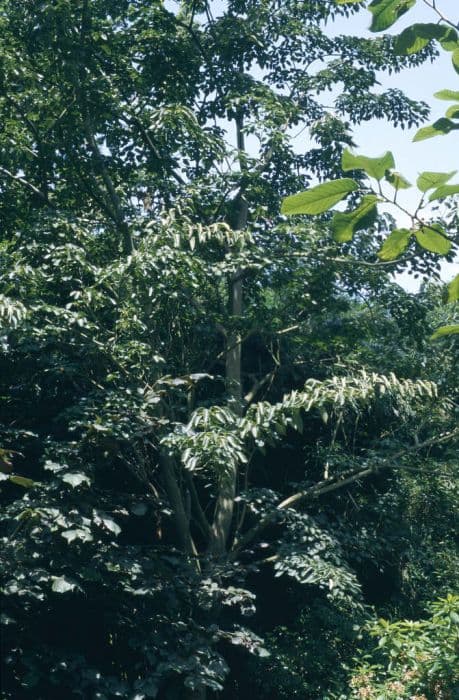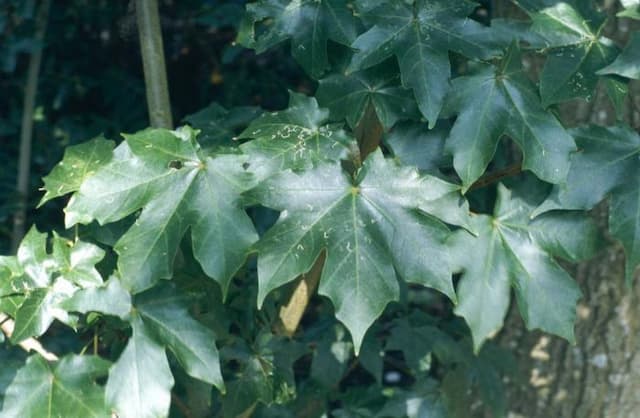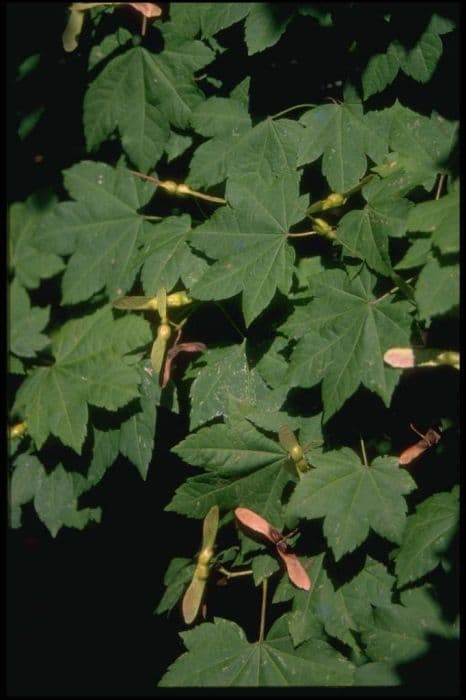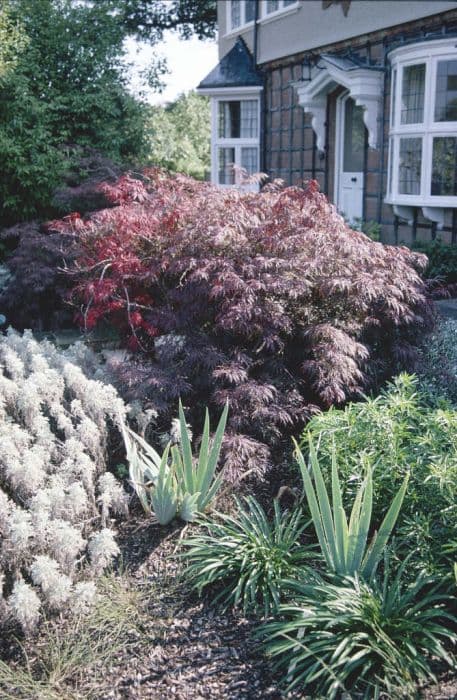Fullmoon maple Acer japonicum 'Vitifolium'

ABOUT
The Acer japonicum 'Vitifolium', commonly known as Fullmoon maple, is characterized by its beautiful and distinct foliage. The leaves of this ornamental tree are quite large and bear a resemblance to those of grapevines, with multiple lobes that create a full, rounded shape reminiscent of a full moon. Each leaf is intricately divided into 7 to 11 lobes, and the edges can be finely serrated, providing a delicate texture. The Fullmoon maple's leaves are appreciated not only for their shape but also for their color display. In spring, the foliage emerges with a vibrant green tone, offering a bright and refreshing look. As the seasons change, the Fullmoon maple provides a dramatic display of autumnal color. The leaves transition to a rich palette of reds, oranges, and sometimes purples, providing a spectacular show and making the plant a prized specimen for fall interest in gardens. Beyond the leaves, the Fullmoon maple produces small, inconspicuous reddish-purple flowers that may be followed by winged seeds, which are known as samaras. The seeds are not particularly showy, but they add extra interest to the plant profile after the flowering period. The overall form of the Fullmoon maple is usually rounded and bushy, giving it a graceful and elegant silhouette. The bark of the Fullmoon maple contributes to its ornamental value, with a smooth texture and a grayish-brown color that stands out against the lush foliage. This plant is often used for its decorative qualities in gardens and landscapes where its striking leaf shapes and colors can be admired. Its beautiful foliage and appealing seasonal changes make the Fullmoon maple a cherished addition for those looking for a plant with visual interest beyond simply flowers or size.
About this plant
 Names
NamesFamily
Sapindaceae.
Synonyms
Fullmoon Maple, Japanese Maple, Downy Japanese Maple, Amur Maple.
Common names
Acer japonicum 'Vitifolium'.
 Toxicity
ToxicityTo humans
Fullmoon maple (Acer japonicum 'Vitifolium') is generally not considered toxic to humans. There is no significant evidence to suggest that ingesting parts of this plant typically causes poisoning or adverse health effects. Hence, there are no common symptoms of poisoning associated with the fullmoon maple for humans.
To pets
Fullmoon maple (Acer japonicum 'Vitifolium') is generally considered non-toxic to pets as well. There are no widely recognized symptoms of poisoning from this plant since it is not known to be harmful to animals when ingested. Therefore, it is unlikely to cause significant health issues for pets.
 Characteristics
CharacteristicsLife cycle
Perennials
Foliage type
Deciduous
Color of leaves
Green
Flower color
Red
Height
15-25 feet [4.5-7.6 meters]
Spread
15-25 feet [4.5-7.6 meters]
Plant type
Tree
Hardiness zones
5
Native area
Japan
Benefits
 General Benefits
General Benefits- Ornamental Value: Acer japonicum 'Vitifolium', commonly known as Fullmoon Maple, has a highly ornamental appeal due to its attractive foliage and stunning fall colors.
- Shade Provider: Its canopy can offer a pleasant shade in gardens and parks.
- Habitat for Wildlife: The tree can provide shelter and food for various bird species and small mammals.
- Low Maintenance: Once established, Fullmoon Maples require minimal care, making them suitable for both amateur and experienced gardeners.
- Seasonal Interest: It provides year-round interest with spring flowers, summer shade, colorful autumn leaves, and a striking branch structure in winter.
- Soil Erosion Control: The root system can help stabilize soil and prevent erosion on slopes.
- Cultural Symbolism: In some cultures, maples are symbols of peace and serenity, which can add an intangible value to a landscape.
- Diversity in Landscaping: It can be used in various landscape designs, including traditional Japanese gardens or as a specimen tree in Western-style landscapes.
 Medical Properties
Medical PropertiesThis plant is not used for medical purposes.
 Air-purifying Qualities
Air-purifying QualitiesThis plant is not specifically known for air purifying qualities.
 Other Uses
Other Uses- Leaf Castings: The uniquely shaped leaves of the Acer japonicum 'Vitifolium' can be used to make decorative leaf castings for garden art or interior design elements.
- Bonsai Specimen: Due to its aesthetic form and foliage, this plant is sometimes trained as a bonsai, offering a challenge for artists and enthusiasts.
- Natural Dyes: The leaves may be used to create natural dyes for fabrics, offering a range of colors from yellow to green depending on the mordant used.
- Photography Backdrops: The vibrant colors of the foliage in autumn provide stunning backdrops for outdoor photography sessions.
- Educational Tool: Schools and botanical gardens often use this plant to educate individuals about different tree species and leaf types.
- Garden Focal Point: With its striking foliage, the Fullmoon maple can be planted as a focal point in a garden design strategy.
- Cultural Symbols: The leaves of the Fullmoon maple can be used in art or crafts to symbolize change and the passing of time, reflecting the change in leaf color.
- Leaf Rubbings: Children can create leaf rubbings with paper and colored pencils or crayons, capturing the intricate vein patterns of the leaves.
- Seasonal Celebrations: In autumn, branches with colorful leaves can be used as natural table centerpieces for seasonal celebrations or events.
- Water Feature Enhancement: The Fullmoon maple can be planted near water features such as ponds or streams, where the reflection of its leaves in the water surface adds to the aesthetic appeal.
Interesting Facts
 Feng Shui
Feng ShuiThe Fullmoon maple is not used in Feng Shui practice.
 Zodiac Sign Compitability
Zodiac Sign CompitabilityThe Fullmoon maple is not used in astrology practice.
 Plant Symbolism
Plant Symbolism- Beauty: The Acer japonicum 'Vitifolium', commonly known as Fullmoon Maple, boasts stunning foliage that changes beautifully throughout the seasons, symbolizing natural beauty and aesthetic appreciation.
- Change: Reflective of the changing leaves which shift from green to bright red or orange in the autumn, the Fullmoon Maple represents the essential and beautiful nature of change and transformation.
- Endurance: As a hardy plant that withstands various climates and conditions, it symbolizes endurance and the ability to thrive through challenges.
- Longevity: With its potential to live for well over a century, the Fullmoon Maple stands as a symbol of longevity and timelessness.
- Peace: In traditional Japanese culture, the maple tree is often associated with peace and tranquility, a reflection of the calm and serene landscapes it often inhabits.
 Water
WaterThe Fullmoon Maple should be watered deeply once a week, providing about 1 to 1.5 gallons of water for young trees, increasing to 2 to 3 gallons for established trees during the growing season. During the hot summer months or in arid climates, increase the frequency to twice per week, ensuring moisture reaches the root zone. In fall and winter, reduce watering to when the soil is dry to the touch, as the tree requires less water during dormancy. Over-watering can lead to root rot, so it's essential to allow the soil to dry out slightly between waterings.
 Light
LightThe Fullmoon Maple thrives best in partial shade or full sun with some afternoon protection in hotter climates. It should be placed in a spot that receives filtered sunlight or 3 to 6 hours of direct morning sun followed by dappled shade. Avoid exposing the tree to harsh, direct afternoon sunlight to prevent leaf scorch.
 Temperature
TemperatureFullmoon Maples are hardy and can withstand a temperature range from -20 to -10 degrees Fahrenheit in winter, but they grow best when the temperature is consistently between 60 and 80 degrees Fahrenheit. They prefer climates with cool summers and do not fare well in regions where temperatures exceed 90 degrees Fahrenheit for extended periods.
 Pruning
PruningPrune the Fullmoon Maple to shape it and remove any dead or damaged branches; this is best done in late winter or early spring before new growth starts. Light pruning can also be performed in summer if necessary to maintain its shape. Thinning out the interior branches every few years will allow light and air to circulate more effectively, promoting the tree's health and vigor.
 Cleaning
CleaningAs needed
 Soil
SoilThe best soil mix for the Fullmoon Maple should be well-draining and acidic to slightly acidic in pH, generally between 5.0 and 6.5. A mix composed of peat, sand, and organic matter or a potting mix designed for acid-loving plants can be ideal. Amending with bark or compost can also help improve drainage and soil structure.
 Repotting
RepottingThe Fullmoon Maple typically needs repotting every 2-3 years; it should be done during the dormant season. Younger or actively growing trees may require more frequent repotting to support their growth.
 Humidity & Misting
Humidity & MistingThe Fullmoon Maple prefers moderate to high humidity levels; maintaining ambient humidity around the plant is desirable. Mist the leaves regularly or use a humidity tray to meet the plant's needs without affecting its watering schedule.
 Suitable locations
Suitable locationsIndoor
Ensure bright, indirect light and keep away from dry heat sources.
Outdoor
Plant in partial shade, shelter from strong winds, and mulch the base.
Hardiness zone
5-7 USDA
 Life cycle
Life cycleThe life cycle of the Fullmoon maple (Acer japonicum 'Vitifolium') begins with seed germination, which occurs when the conditions are warm and moist, typically in the spring. The germinated seeds develop into seedlings, which form a taproot and begin to sprout their first set of true leaves. As the seedlings grow and mature into saplings over several years, they develop a more extensive root system and a woody stem. Fullmoon maple reaches maturity in several years, starting to produce flowers that are usually small and inconspicuous, leading to the development of winged samaras or "helicopter seeds." These seeds, once dispersed by wind, can give rise to new plants, completing the reproductive cycle. Throughout its adult life, the Fullmoon maple experiences annual cycles of growth, with leaves changing color spectacularly in the fall before they are shed, and the plant going into dormancy during the winter.
 Propogation
PropogationPropogation time
Late winter-early spring
Propogation: Acer japonicum 'Vitifolium', commonly known as Fullmoon Maple, is typically propagated through grafting, the most popular method for this species. Grafting should be done in late winter or early spring before the sap starts to flow. This involves taking a scion, or a young shoot with buds, from the Fullmoon Maple and joining it to a rootstock of another maple variety. The cut surfaces of both the scion and rootstock are matched up and firmly bound with grafting tape. The grafted joint is then sealed with grafting wax or a similar sealant to prevent desiccation and protect against pathogens. ByValentine's Day, the graft should have taken, and the tape can be removed once the scion has started to grow actively, usually in late spring or early summer.









